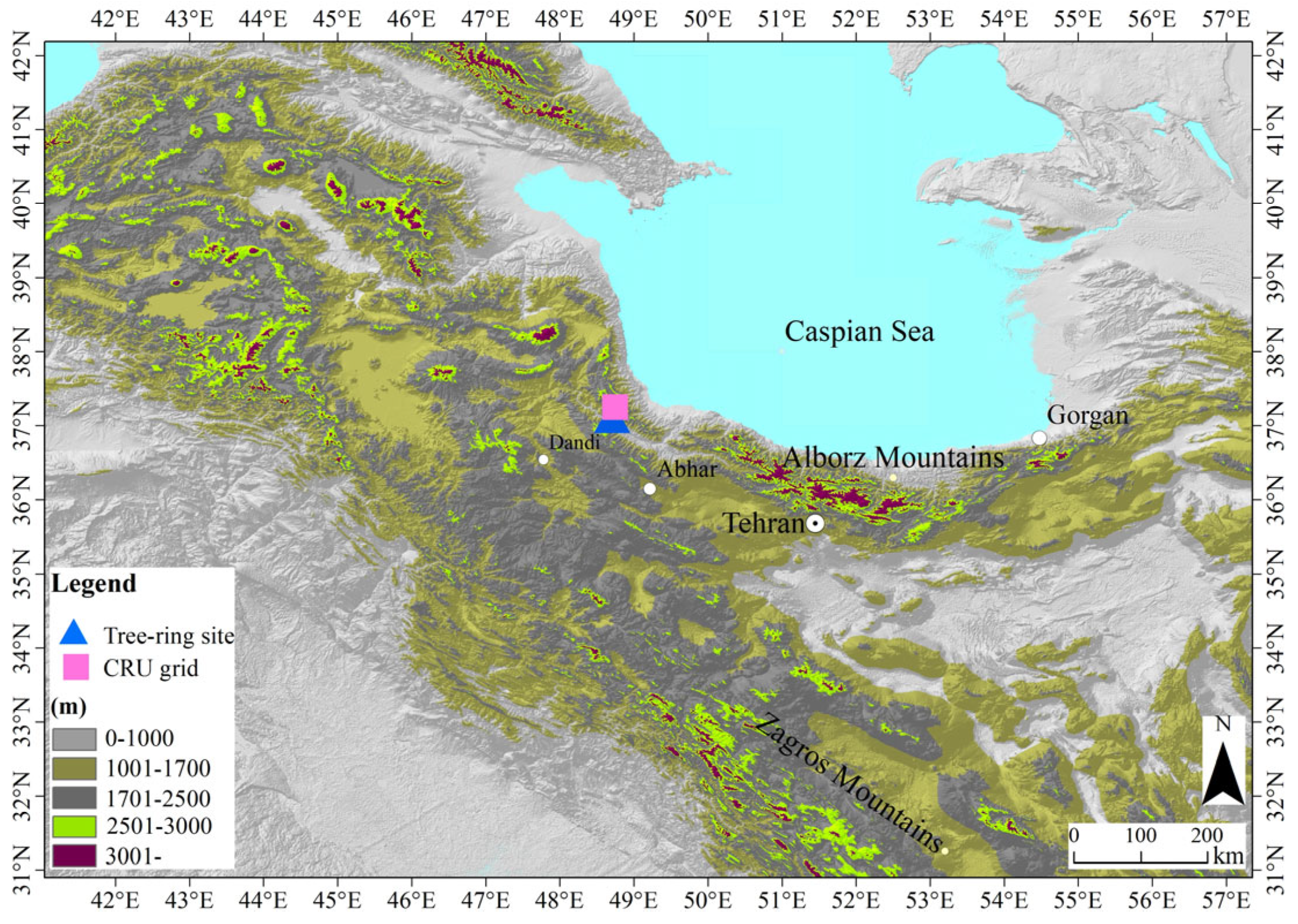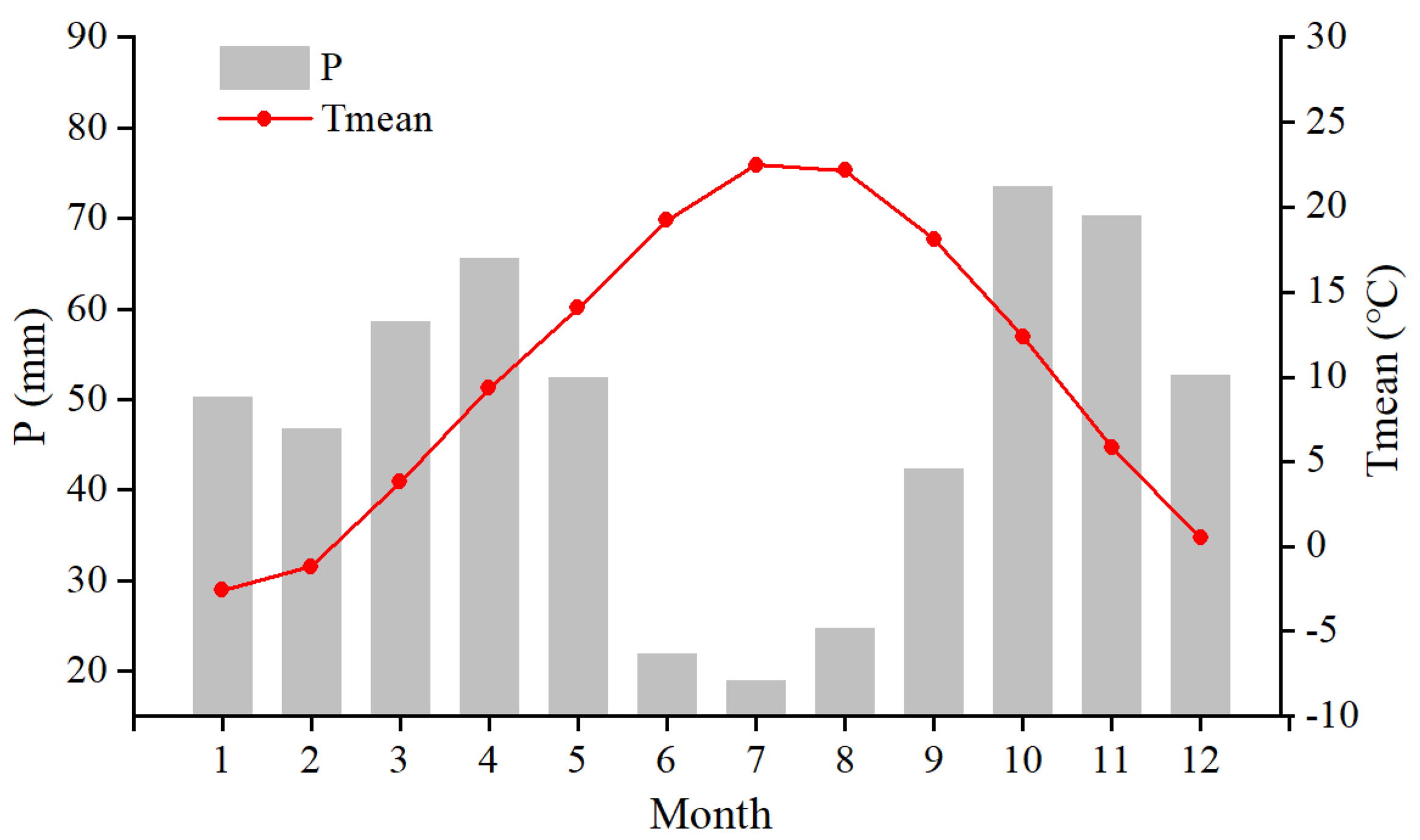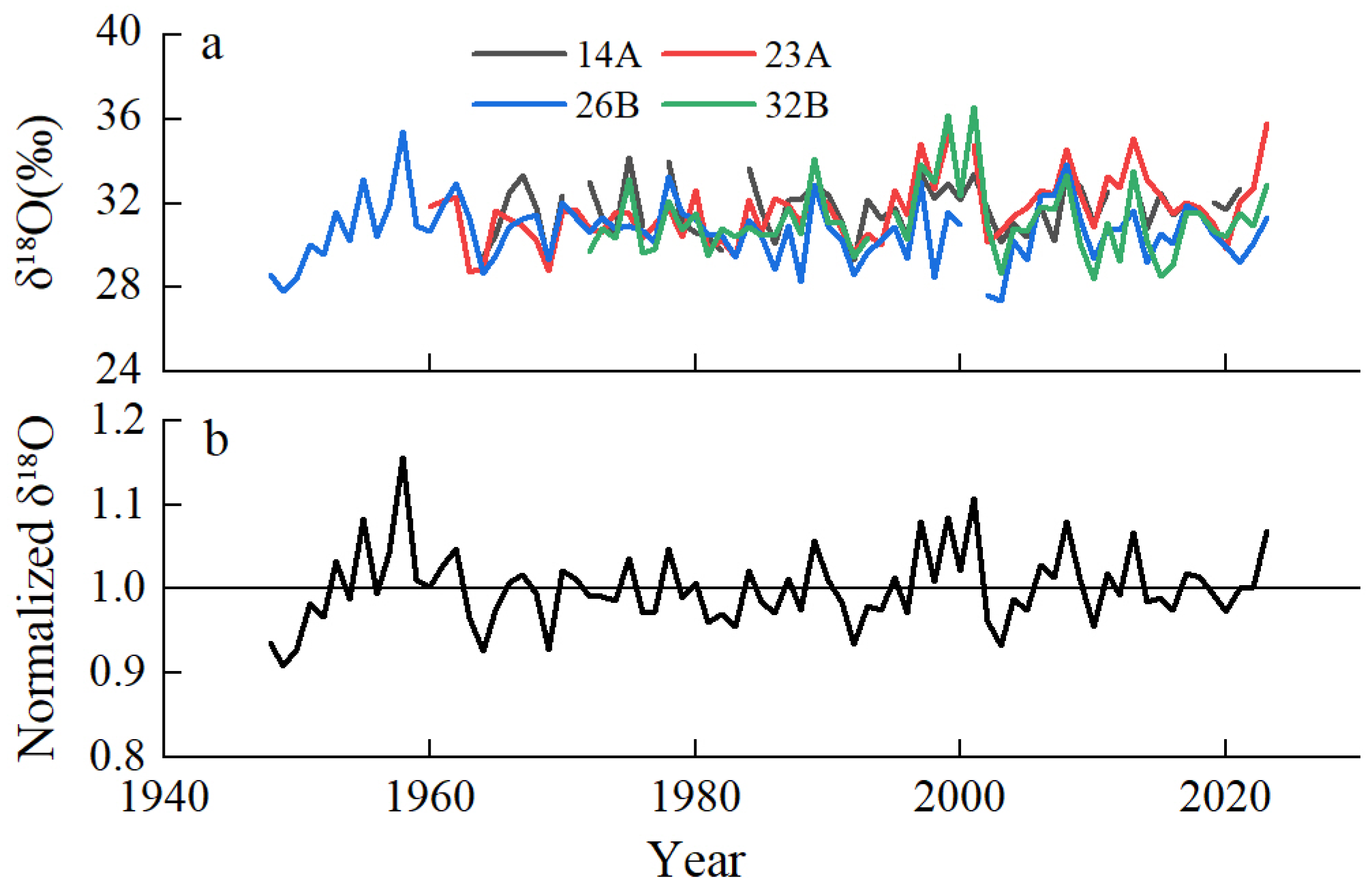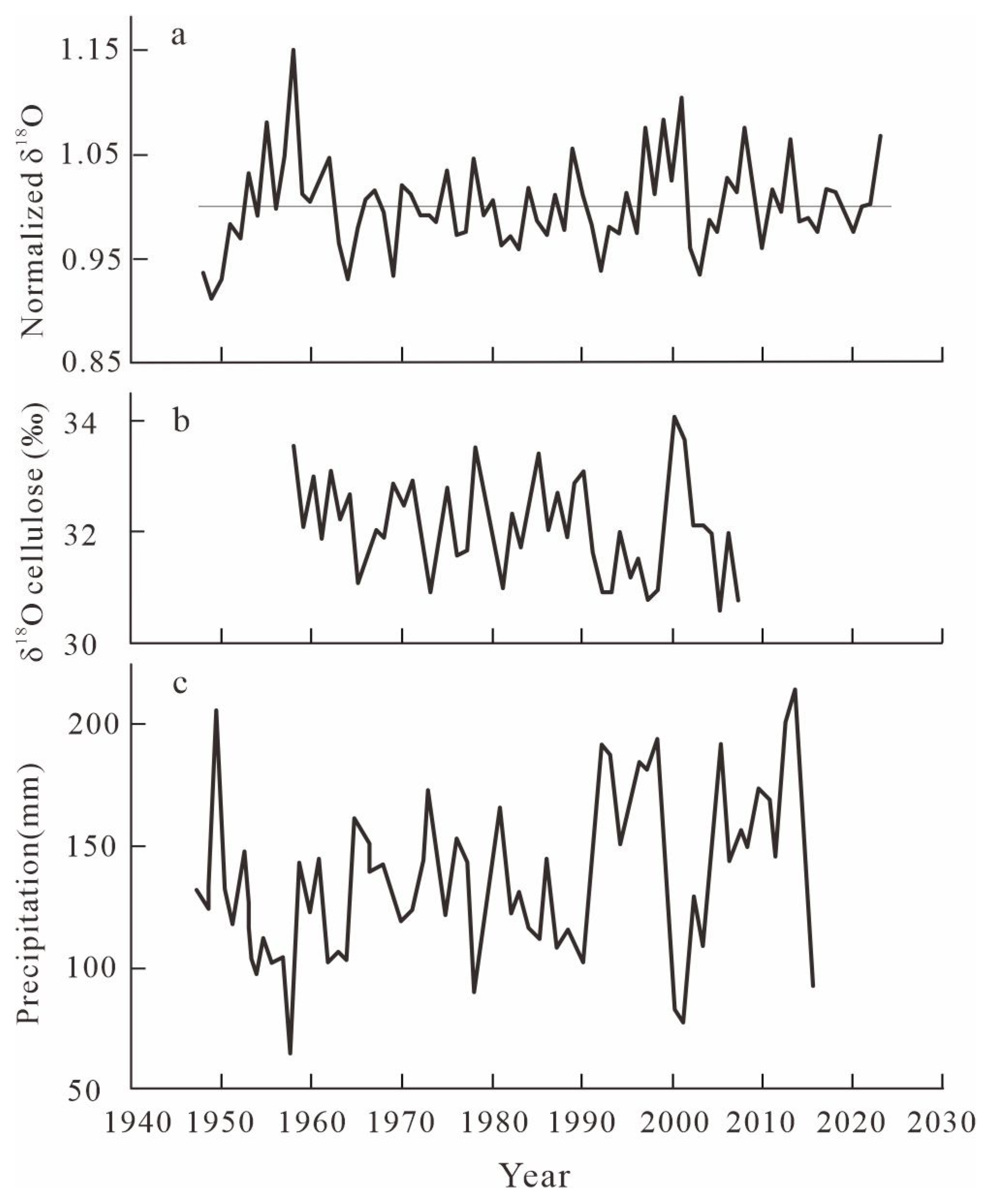Response of Tree-Ring Oxygen Isotopes to Climate Variations in the Banarud Area in the West Part of the Alborz Mountains
Abstract
1. Introduction
2. Materials and Methods
2.1. Tree-Ring Sampling
2.2. Cross-Dating and Oxygen Isotope Analysis
2.3. Climate Data and Analysis Methods
3. Results
3.1. Characteristics of the δ18O Series
3.2. Correlation Between δ18O and Climate Factors
3.2.1. Precipitation Relationships
3.2.2. Temperature Relationships
3.2.3. Drought Index Relationships
3.2.4. Vapor Pressure and Evapotranspiration Relationships
3.3. Correlation Between δ18O and Large-Scale Climate Indices
4. Discussion
4.1. Sensitivity Mechanisms of Tree-Ring δ18O to Climate Factors
4.1.1. Precipitation Effects
4.1.2. Temperature Effects
4.1.3. Drought Index Effects
4.1.4. Vapor Pressure and Evapotranspiration Effects
4.1.5. Integrated Response Pattern
4.2. Comparison with the δ18O Record from the Eastern Alborz Mountains
4.3. Response Mechanisms Analysis to Large-Scale Climate Indices
4.3.1. ENSO Influence
4.3.2. Limited Atlantic Influence
5. Conclusions
Author Contributions
Funding
Data Availability Statement
Acknowledgments
Conflicts of Interest
References
- Mccarroll, D.; Loader, N.J. Stable isotopes in tree rings. Quat. Sci. Rev. 2004, 23, 771–801. [Google Scholar] [CrossRef]
- Siegwolf, R.T.; Brooks, J.R.; Roden, J.; Saurer, M. Stable Isotopes in Tree Rings: Inferring Physiological, Climatic and Environmental Responses; Springer Nature: Cham, Switzerland, 2022. [Google Scholar]
- Gessler, A.; Ferrio, J.P.; Hommel, R.; Treydte, K.; Werner, R.A.; Monson, R.K. Stable isotopes in tree rings: Towards a mechanistic understanding of isotope fractionation and mixing processes from the leaves to the wood. Tree Physiol. 2014, 34, 796–818. [Google Scholar] [CrossRef]
- Liu, X.; Shao, X.; Liang, E.; Chen, T.; Qin, D.; An, W.; Xu, G.; Sun, W.; Wang, Y. Climatic significance of tree-ring δ18O in the Qilian Mountains, northwestern China and its relationship to atmospheric circulation patterns. Chem. Geol. 2009, 268, 147–154. [Google Scholar] [CrossRef]
- Zhao, F.; Fan, Z.; Su, T.; Li, S.; Tang, H.; Spicer, T.E.; Zhou, Z. Tree-ring δ18O inferred spring drought variability over the past 200 years in the Hengduan Mountains, Southwest China. Palaeogeogr. Palaeoclimatol. Palaeoecol. 2019, 518, 22–33. [Google Scholar] [CrossRef]
- Chen, D.; Zhou, F.; Dong, Z.; Zeng, A.Y.; Ou, T.; Fang, K. A tree-ring δ18O based reconstruction of East Asia summer monsoon over the past two centuries. PLoS ONE 2020, 15, e234421. [Google Scholar] [CrossRef] [PubMed]
- Shi, S.; Shi, J.; Xu, C.; Leavitt, S.W.; Wright, W.E.; Cai, Z.; Zhang, H.; Sun, X.; Zhao, Y.; Ma, X. Tree-ring δ18O from Southeast China reveals monsoon precipitation and ENSO variability. Palaeogeogr. Palaeoclimatol. Palaeoecol. 2020, 558, 109954. [Google Scholar] [CrossRef]
- Fonti, M.V.; Saurer, M.; Guillet, S.; Corona, C.; Fonti, P.; Myglan, V.S.; Kirdyanov, A.V.; Naumova, O.V.; Ovchinnikov, D.V.; Shashkin, A.V. Siberian tree-ring and stable isotope proxies as indicators of temperature and moisture changes after major stratospheric volcanic eruptions. Clim. Past 2019, 15, 685–700. [Google Scholar] [CrossRef]
- Churakova, O.V.; Porter, T.J.; Kirdyanov, A.V.; Myglan, V.S.; Fonti, M.V.; Vaganov, E.A. Stable isotopes in tree rings of boreal forests. In Stable Isotopes in Tree Rings: Inferring Physiological, Climatic and Environmental Responses; Siegwolf, R.T., Brooks, J.R., Roden, J., Saurer, M., Eds.; Springer Nature Switzerland AG: Cham, Switzerland, 2022; pp. 581–603. [Google Scholar]
- An, W.; Liu, X.; Leavitt, S.W.; Xu, G.; Zeng, X.; Wang, W.; Qin, D.; Ren, J. Relative humidity history on the Batang–Litang Plateau of western China since 1755 reconstructed from tree-ring δ18O and δD. Clim. Dynam. 2014, 42, 2639–2654. [Google Scholar] [CrossRef]
- Bayramzadeh, V.; Zhu, H.; Lu, X.; Attarod, P.; Zhang, H.; Li, X.; Asad, F.; Liang, E. Temperature variability in northern Iran during the past 700 years. Sci. Bull. 2018, 63, 462–464. [Google Scholar] [CrossRef]
- Gholami, V.; Chau, K.W.; Fadaee, F.; Torkaman, J.; Ghaffari, A. Modeling of groundwater level fluctuations using dendrochronology in alluvial aquifers. J. Hydrol. 2015, 529, 1060–1069. [Google Scholar] [CrossRef]
- Gholami, V.; Ahmadi Jolandan, M.; Torkaman, J. Evaluation of climate change in northern Iran during the last four centuries by using dendroclimatology. Nat. Hazards 2017, 85, 1835–1850. [Google Scholar] [CrossRef]
- Gholami, V.; Sahour, H.; Torkaman, J. Monthly river flow modeling using earlywood vessel feature changes, and tree-rings. Ecol. Indic. 2021, 125, 107590. [Google Scholar] [CrossRef]
- Ghorbani, K.; Mohammadi, J.; Rezaei Ghaleh, L. Annual growth of Fagus orientalis is limited by spring drought conditions in Iran’s Golestan Province. J. For. Res. 2024, 35, 19. [Google Scholar] [CrossRef]
- Haghshenas, M.; Mohadjer, M.R.M.; Attarod, P.; Pourtahmasi, K.; Feldhaus, J.; Sadeghi, S.M.M. Climate effect on tree-ring widths of Fagus orientalis in the Caspian forests, northern Iran. For. Sci. Technol. 2016, 12, 176–182. [Google Scholar] [CrossRef]
- Kiaei, M.; Bakhshi, R. A dendrochronological study on Acer velutinum in northern Iran. Indian J. Sci. Technol. 2011, 4, 1547–1550. [Google Scholar] [CrossRef]
- Moradi, H.; Schwab, N.; Schickhoff, U. Long-term tree growth-climate relationships of Fagus orientalis Lipsky at high-elevation forest edges in the Alborz Mountains, northern Iran. Dendrochronologia 2025, 91, 126306. [Google Scholar] [CrossRef]
- Pourtahmasi, K.; Parsapjouh, D.; Bräuning, A.; Esper, J.; Schweingruber, F.H. Climatic analysis of pointer years in tree-ring chronologies from northern Iran and neighboring high mountain areas. Geoöko 2007, 28, 27–42. [Google Scholar]
- Foroozan, Z.; Pourtahmasi, K.; Bräuning, A. Stable oxygen isotopes in juniper and oak tree rings from northern Iran as indicators for site-specific and season-specific moisture variations. Dendrochronologia 2015, 36, 33–39. [Google Scholar] [CrossRef]
- Foroozan, Z.; Pourtahmasi, K.; Bräuning, A. Climatic signals in stable carbon isotope ratios of Juniper and Oak tree rings from northern Iran. Glob. Planet. Chang. 2018, 165, 90–99. [Google Scholar] [CrossRef]
- Foroozan, Z.; Grießinger, J.; Pourtahmasi, K.; Bräuning, A. 501 Years of spring precipitation history for the semi-arid northern Iran derived from tree-ring δ18O data. Atmosphere 2020, 11, 889. [Google Scholar] [CrossRef]
- Gholami, V.; Torkaman, J.; Khaleghi, M.R. Dendrohydrogeology in paleohydrogeologic studies. Adv. Water Resour. 2017, 110, 19–28. [Google Scholar] [CrossRef]
- Gholami, V.; Torkaman, J.; Dalir, P. Simulation of precipitation time series using tree-rings, earlywood vessel features, and artificial neural network. Theor. Appl. Climatol. 2019, 137, 1939–1948. [Google Scholar] [CrossRef]
- Mousavisangdehi, A.; Oladi, R.; Pourtahmasi, K.; Etemad, V.; Koprowski, M.; Tumajer, J. Higher temperatures promote intra-annual radial growth of Oriental beech (Fagus orientalis Lipsky) in the humid Hyrcanian forests. Trees 2024, 38, 1569–1580. [Google Scholar] [CrossRef]
- Oladi, R.; Pourtahmasi, K.; Eckstein, D.; Bräuning, A. Seasonal dynamics of wood formation in Oriental beech (Fagus orientalis Lipsky) along an altitudinal gradient in the Hyrcanian forest, Iran. Trees 2011, 25, 425–433. [Google Scholar] [CrossRef]
- Pourtahmasi, K.; Lotfiomran, N.; Bräuning, A.; Parsapajouh, D. Tree-ring width and vessel characteristics of oriental beech (Fagus orientalis) along an altitudinal gradient in the Caspian forests, northern Iran. IAWA J. 2011, 32, 461–473. [Google Scholar] [CrossRef]
- Nadi, M.; Bazrafshan, J.; Pourtahmasi, K.; Bräuning, A. Tree-ring based reconstruction of the joint deficit index in Javan-Roud Region, Kermanshah (Iran). Int. J. Climatol. 2017, 37, 420–429. [Google Scholar] [CrossRef]
- Arsalani, M.; Grießinger, J.; Bräuning, A. Tree-ring-based seasonal temperature reconstructions and ecological implications of recent warming on oak forest health in the Zagros Mountains, Iran. Int. J. Biometeorol. 2022, 66, 2553–2565. [Google Scholar] [CrossRef]
- Beiranvand, S.; Bayramzadeh, V.; Attarod, P.; Pourtahmasi, K.; Pypker, T.G.; Bräuning, A.; Nadi, M. Increasing drought frequency in the central Zagros Mountains of western Iran over the past two centuries. J. Arid Environ. 2024, 224, 105240. [Google Scholar] [CrossRef]
- Holmes, R.L. Computer-assisted quality control in tree-ring dating and measurement. Tree-Ring Bull. 1983, 43, 51–67. [Google Scholar]
- Cook, E.R. A Time Series Analysis Approach to Tree Ring Standardization; The University of Arizona: Tucson, AZ, USA, 1985. [Google Scholar]
- Harris, I.; Osborn, T.J.; Jones, P.; Lister, D. Version 4 of the CRU TS monthly high-resolution gridded multivariate climate dataset. Sci. Data 2020, 7, 109. [Google Scholar] [CrossRef]
- Trenberth, K.E. The definition of El Niño. Bull. Am. Meteorol. Soc. 1997, 78, 2771–2778. [Google Scholar] [CrossRef]
- Sauvage, J.C.D.; Saurer, M.; Treydte, K.; Lévesque, M. Decoupling of tree-ring cllulose δ18O and δ2H highlighted by their contrasting relationships to climate and tree intrinsic variables. Plant Cell Environ. 2025, 48, 1903–1918. [Google Scholar] [CrossRef]
- Dansgaard, W. Stable isotopes in precipitation. Tellus 1964, 16, 436–468. [Google Scholar] [CrossRef]
- Janecka, K.; Treydte, K.; Piccinelli, S.; Francon, L.; Argelich Ninot, M.; Edvardsson, J.; Corona, C.; Lehsten, V.; Stoffel, M. Peatland trees record strong and temporally stable hydroclimate information in tree-ring δ13C and δ18O. EGUsphere 2025, 2025, 1–35. [Google Scholar] [CrossRef]
- Dahlke, H.E.; Lyon, S.W. Early melt season snowpack isotopic evolution in the Tarfala valley, northern Sweden. Ann. Glaciol. 2013, 54, 149–156. [Google Scholar] [CrossRef]
- Roden, J.S.; Lin, G.; Ehleringer, J.R. A mechanistic model for interpretation of hydrogen and oxygen isotope ratios in tree-ring cellulose. Geochim. Cosmochim. Ac. 2000, 64, 21–35. [Google Scholar] [CrossRef]
- Barbour, M.M. Stable oxygen isotope composition of plant tissue: A review. Funct. Plant Biol. 2007, 34, 83–94. [Google Scholar] [CrossRef] [PubMed]
- Saurer, M.; Borella, S.; Leuenberger, M. δ18O of tree rings of beech (Fagus silvatica) as a record of δ18O of the growing season precipitation. Tellus B Chem. Phys. Meteorol. 1997, 49, 80–92. [Google Scholar] [CrossRef]
- Sano, M.; Dimri, A.P.; Ramesh, R.; Xu, C.; Li, Z.; Nakatsuka, T. Moisture source signals preserved in a 242-year tree-ring δ18O chronology in the western Himalaya. Glob. Planet. Change 2017, 157, 73–82. [Google Scholar] [CrossRef]
- Liu, Y.; Fang, C.; Li, Q.; Song, H.; Ta, W.; Zhao, G.; Sun, C. Tree-ring δ18O based PDSI reconstruction in the Mt. Tianmu region since 1618 AD and its connection to the East Asian summer monsoon. Ecol. Indic. 2019, 104, 636–647. [Google Scholar] [CrossRef]
- Sano, M.; Xu, C.; Nakatsuka, T. A 300-year Vietnam hydroclimate and ENSO variability record reconstructed from tree ring δ18O. J. Geophys. Res. Atmos. 2012, 117, D12115. [Google Scholar] [CrossRef]
- Grießinger, J.; Bräuning, A.; Thomas, A.; Schleser, G.H. Stable oxygen isotopes in juniper trees from the Tibetan plateau as a proxy for monsoonal activity. Tree-Rings Archaeol. Climatol. Ecol. 2008, 6, 110–114. [Google Scholar] [CrossRef]
- Nagavciuc, V.; Helle, G.; Rădoane, M.; Roibu, C.; Cotos, M.; Ionita, M. A long-term drought reconstruction based on oxygen isotope tree ring data. EGUsphere 2024, 2024, 1–22. [Google Scholar] [CrossRef]
- Alizadeh-Choobari, O.; Najafi, M.S. Extreme weather events in Iran under a changing climate. Clim. Dyn. 2018, 50, 249–260. [Google Scholar] [CrossRef]
- Thompson, D.W.; Wallace, J.M. The Arctic Oscillation signature in the wintertime geopotential height and temperature fields. Geophys. Res. Lett. 1998, 25, 1297–1300. [Google Scholar] [CrossRef]
- Hurrell, J.W. Decadal trends in the North Atlantic Oscillation: Regional temperatures and precipitation. Science 1995, 269, 676–679. [Google Scholar] [CrossRef]
- Ropelewski, C.F.; Halpert, M.S. Global and regional scale precipitation patterns associated with the El Niño/Southern Oscillation. Mon. Weather Rev. 1987, 115, 1606–1626. [Google Scholar] [CrossRef]
- Wang, B.; Wu, R.; Fu, X. Pacific–East Asian teleconnection: How does ENSO affect East Asian climate? J. Clim. 2000, 13, 1517–1536. [Google Scholar] [CrossRef]
- Ma, S.; Wang, T.; Xie, T.; Gao, L.; Wei, B.; Chen, J.; Chen, F.; Huang, W. Interdecadal pacific variability dominated the decadal variation of cold season precipitation in arid west Asia. Atmos. Res. 2023, 288, 106730. [Google Scholar] [CrossRef]






| Dataset Name | Variable(s) | Spatial Resolution | Temporal Coverage | Source |
|---|---|---|---|---|
| CRU TS v4.08 | P, T, PET, et al. | 0.5° × 0.5° global grid | 1901–2023 | https://climexp.knmi.nl, accessed on 24 April 2025 |
| AO Index | Sea-level pressure anomaly | Northern Hemisphere | 1950–present | https://www.cpc.ncep.noaa.gov/products/precip/CWlink/daily_ao_index/ao.shtml, accessed on around 14 May 2025 |
| NAO Index | Sea-level pressure anomaly | North Atlantic Region | 1950–present | https://www.cpc.ncep.noaa.gov/products/precip/CWlink/pna/nao.shtml, accessed on around 14 May 2025 |
| Niño 3.4 SST Index | SST | Equatorial Pacific | 1870–present | https://www.psl.noaa.gov/data/index.html, accessed on around 14 May 2025 |
Disclaimer/Publisher’s Note: The statements, opinions and data contained in all publications are solely those of the individual author(s) and contributor(s) and not of MDPI and/or the editor(s). MDPI and/or the editor(s) disclaim responsibility for any injury to people or property resulting from any ideas, methods, instructions or products referred to in the content. |
© 2025 by the authors. Licensee MDPI, Basel, Switzerland. This article is an open access article distributed under the terms and conditions of the Creative Commons Attribution (CC BY) license (https://creativecommons.org/licenses/by/4.0/).
Share and Cite
Wang, Y.; Chen, S.; Xie, H.; Su, Y.; Ma, S.; Xie, T. Response of Tree-Ring Oxygen Isotopes to Climate Variations in the Banarud Area in the West Part of the Alborz Mountains. Forests 2025, 16, 1238. https://doi.org/10.3390/f16081238
Wang Y, Chen S, Xie H, Su Y, Ma S, Xie T. Response of Tree-Ring Oxygen Isotopes to Climate Variations in the Banarud Area in the West Part of the Alborz Mountains. Forests. 2025; 16(8):1238. https://doi.org/10.3390/f16081238
Chicago/Turabian StyleWang, Yajun, Shengqian Chen, Haichao Xie, Yanan Su, Shuai Ma, and Tingting Xie. 2025. "Response of Tree-Ring Oxygen Isotopes to Climate Variations in the Banarud Area in the West Part of the Alborz Mountains" Forests 16, no. 8: 1238. https://doi.org/10.3390/f16081238
APA StyleWang, Y., Chen, S., Xie, H., Su, Y., Ma, S., & Xie, T. (2025). Response of Tree-Ring Oxygen Isotopes to Climate Variations in the Banarud Area in the West Part of the Alborz Mountains. Forests, 16(8), 1238. https://doi.org/10.3390/f16081238





